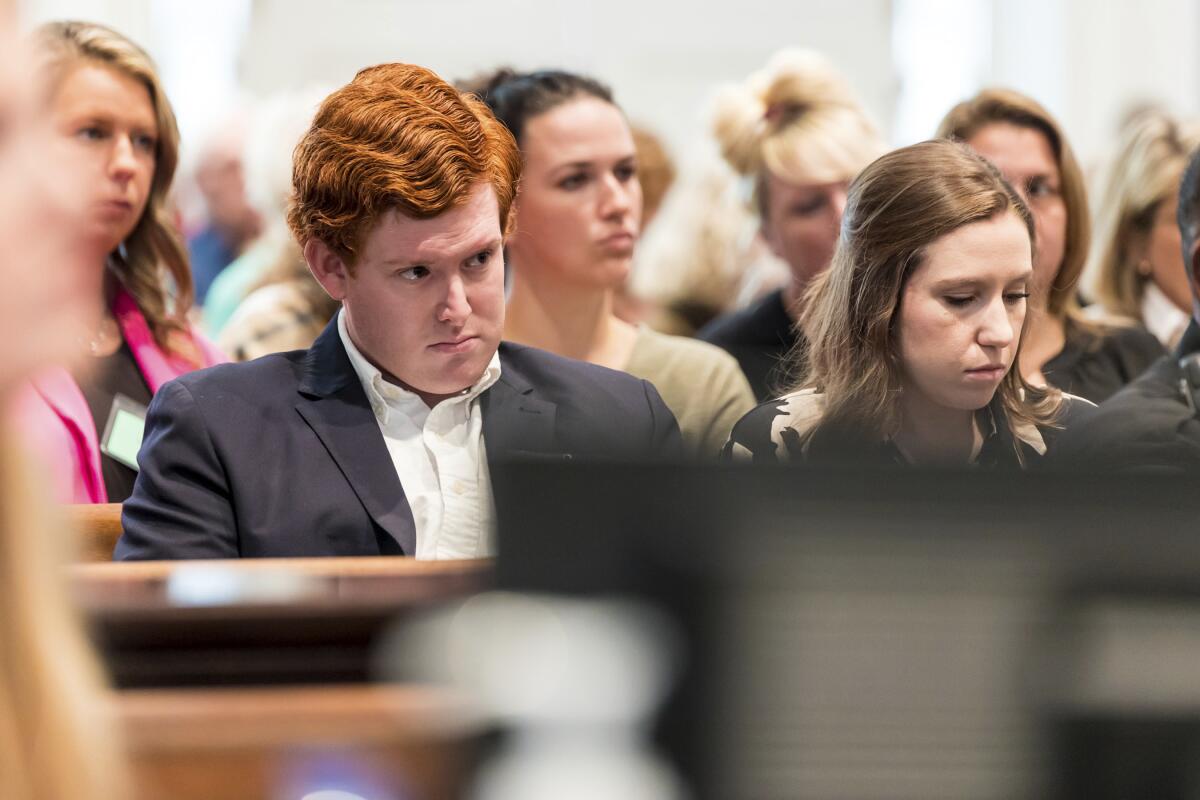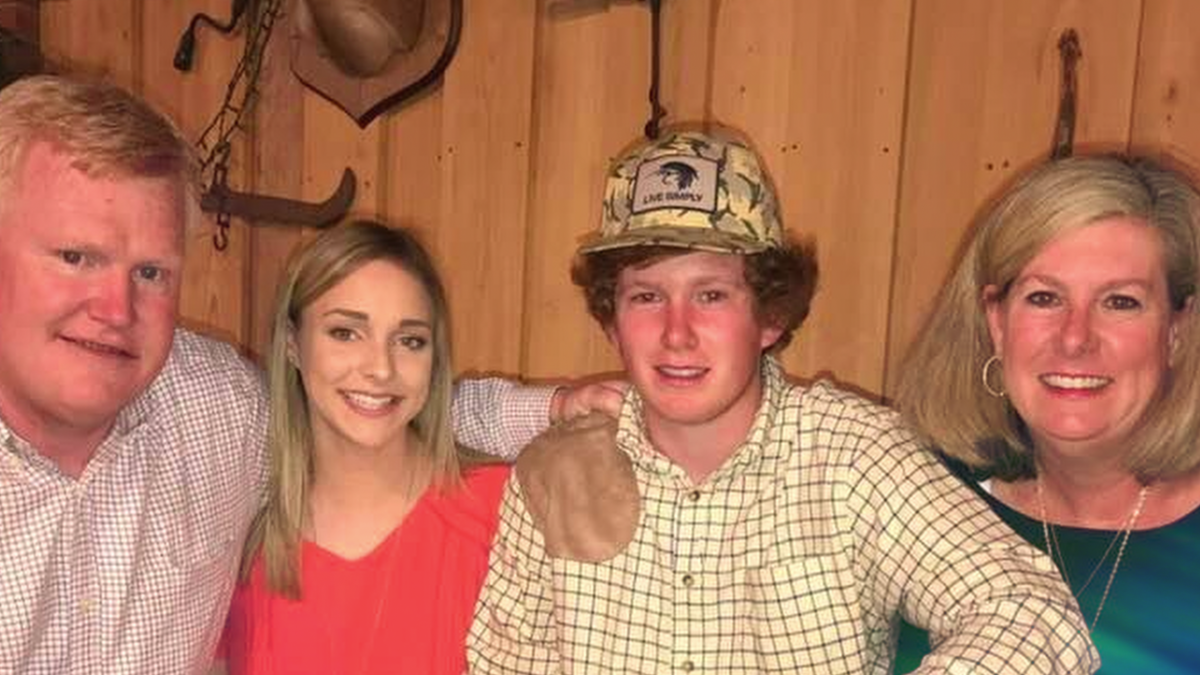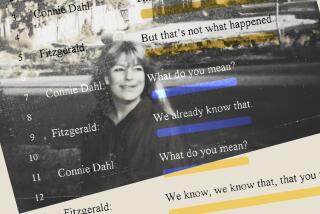Murdaughs, murder and the birth of TV’s newest true-crime sensation

- Share via
Pat Conroy. Truman Capote. John Grisham. Shakespeare.
The epic downfall of Alex Murdaugh, the once-mighty South Carolina attorney currently on trial for the brutal killings of his wife and son and implicated in numerous other crimes, has prompted a slew of literary comparisons — none of which quite capture the full scope of this twisted saga.
A Southern Gothic tale of greed and deceit, it has also become the country’s latest true-crime obsession. Hundreds of thousands of people tune in to daily livestreams of the trial, being held in the small town of Walterboro, S.C.
The televised proceedings have helped fuel an already thriving Murdaugh cottage industry. There’s a top-rated podcast, “Murdaugh Murders,” created by Mandy Matney, a tenacious local reporter who broke many of the crucial stories in the case.
There are also specials on “Dateline,” “48 Hours” and “20/20”; a 7,000-word New Yorker deep dive; and docuseries from HBO Max (“Low Country: The Murdaugh Dynasty”) and Discovery+ (“Murdaugh Murders: Deadly Dynasty”). This week, as the trial stretches into its second month with the outcome far from certain, Netflix enters the fray with “Murdaugh Murders: A Southern Scandal,” a three-part docuseries.
From ‘Unsolved Mysteries’ to ‘I’ll Be Gone in the Dark,’ true crime is ubiquitous on TV. But it may not be as impactful as its cultural footprint suggests.
To a casual observer, this glut of coverage might seem excessive. But Will Folks, founding editor of FITSNews, a South Carolina news and politics site that has risen to national attention through its Murdaugh scoops, sees it another way.
“It is one of the most gripping dramas we’ll ever see in the true-crime arena, because no one knows yet how it’s going to end,” he said. “It’s got every single ingredient you look for in a whodunit. Then you layer on top of that the power, the influence of this family, all these other cases that are tied to them and this perfect backdrop [of the Lowcountry] — it’s a point of critical mass for a storyteller. You’ll live your whole life and never get another one like this.”
Any effort to summarize this unwieldy saga is likely doomed to fail, but here’s an attempt anyway: For nearly a century, the Murdaugh family reigned over South Carolina’s Lowcountry, an economically depressed region in the southern corner of the state known for its picturesque salt marshes and legal corruption. For multiple generations, the Murdaughs served as solicitors — the local equivalent of a prosecutor — while also operating a lucrative private firm specializing in personal injury lawsuits.
But their fiefdom began to unravel in 2019, when, according to witnesses, younger son Paul, then 19, drunkenly crashed a boat into a bridge. The crash killed a young woman named Mallory Beach, whose parents brought a lawsuit against Alex. Paul was facing a number of felony charges when, in June 2021, he and his mother were shot to death outside the dog kennels on their family’s 1,700-acre hunting estate.
A few months later, Murdaugh was forced to resign from his family firm amid allegations he misused funds. A day later, he called 911 to say he’d been shot in the head in a botched roadside assassination attempt. The story quickly fell apart: Murdaugh eventually admitted he’d hired a distant cousin, Curtis “Eddie” Smith, to kill him in an attempt to secure a life insurance payout for his surviving son, Buster. He also claimed to be struggling with opioid addiction. In July 2022, Murdaugh was indicted on two counts of murder.
The spotlight has also brought renewed scrutiny to two suspicious deaths: Stephen Smith, a gay 19-year-old who was killed in 2015 in what many believe was a hate crime staged to look like a hit and run on a rural road in Hampton County; and Gloria Satterfield, the Murdaugh family’s longtime housekeeper, who died after falling down the steps at the family’s country estate in 2018, leading to a multimillion-dollar settlement that Murdaugh allegedly embezzled from Satterfield’s sons.
Got all that?
“It checks the boxes on all criminality,” said Eric Bland, a malpractice attorney who represented the Satterfield estate in their proceedings against Murdaugh and co-hosts a podcast about the Murdaughs, “Cup of Justice.” “There’s drugs, betrayal of friends, family and clients. There’s roadside shootings with Cousin Eddie. All John Grisham has to do is come down here and write the story. He doesn’t need to take a hit of acid or a marijuana gummy to come up with it.”

At the center of it all is the ruddy, ginger-haired Alex Murdaugh — a banal criminal defendant in topsiders who, prosecutors argue, killed his wife and son in a desperate bid to deflect attention from his alleged financial crimes.
The trial, which began in late January, has brought a throng of journalists to the Colleton County Courthouse. The testimony has ranged from harrowing (a forensic pathologist describing Paul and Maggie Murdaugh’s fatal injuries in graphic detail) to colorfully mundane (a caretaker explaining the layout of the kennel, which housed dogs named Armadillo, Tappy Toes and Bubba).
Alex Murdaugh, who faces life in prison without parole, has pleaded not guilty to the two counts of murder and weapons charges. With no witnesses, weapons or other direct evidence tying the disgraced attorney to the murders, the prosecution’s case has been built on a trove of circumstantial evidence. His defense has argued that the same Snapchat video that Paul Murdaugh sent to friends before he was killed — allegedly placing Alex Murdaugh at the crime scene — shows a “loving” father and son laughing about planting trees, not an enraged man capable of murder.
In opening statements, defense attorney Dick Harpootlian said Alex Murdaugh had neither the motive nor the time to commit the murders and visit his mother’s house in a nearby town immediately after. He also argued that investigators found no blood on Alex Murdaugh’s clothes from that night. Meanwhile, a forensic engineering expert for the defense testified that Alex Murdaugh was too tall to be the shooter, based on the projection of one of the bullets at the crime scene.
The inherent drama of the case has been heightened by external forces, including a bomb scare that forced the evacuation of the packed courthouse, a COVID-19 breakout that has rippled through the jury and the daily presence of Buster Murdaugh, a husky redhead with a strong resemblance to his father and late brother.
The evidence against Alex — pronounced “Ellick” by friends and family, in one of many regional quirks that define this case — includes a video on Paul’s cellphone that places him at the scene of the crime minutes before it likely occurred, and testimony from a family caregiver who said Alex asked her to lie about the timing of a visit to his mother on the night of the murders.
The trial has been a massive draw for the Law & Crime network. “We knew it was going to be big, but I don’t think any of us realized it was going to garner this much interest,” said executive producer Cathy Russon, who drew a comparison between the multi-tentacled Murdaugh case and that of Robert Durst, the real estate heir accused of committing multiple murders over decades.
From Netflix’s new ‘Unsolved Mysteries’ to ‘A Wilderness of Error,’ true-crime TV is rife with re-creations. But the trope raises ethical issues.
As the prosecution’s case has stretched out for weeks, the audience for the network’s livestream on YouTube has grown, now drawing about 100,000 viewers at any given moment, many of whom share their real-time reactions in a chat sidebar. (Giddy popcorn emojis are a recurring motif.)
“The longer a trial goes,” Russon said, “the more opportunity people have to get really invested in it.” As it did in the Johnny Depp-Amber Heard defamation trial last year, the network presents all the camera feeds at once in a split screen, enabling viewers to see Murdaugh’s reaction to testimony — a feature that gives their coverage an edge over the competition, Russon said.
In her view, gawkers are drawn to Murdaugh’s case for a simple reason: “He’s a scumbag who had it all. He’s privileged, he’s wealthy and that wasn’t good enough.”

There’s a mutually beneficial relationship between the live trial coverage and the various documentary projects. “Low Country,” the HBO Max series, premiered late last year, drawing interest to the trial starting in January.
“Murdaugh Murders: A Southern Scandal” arrives on Netflix this week, as the defense begins to mount its case — “the most serendipitous thing you could ever ask for as a documentary filmmaker,” said Jenner Furst, who directed the series with Julia Willoughby Nason. The team, whose previous credits include Hulu’s “Fyre Fraud,” about the disastrous Fyre Festival, and Amazon Prime Video’s “LuLaRich,” about the multilevel marketing company known for its garish leggings, is used to tackling competitive subjects.
“We’ve been at the dawn of the dueling documentary crisis,” said Furst. “Every time we do one of these things, there are four other crews [on the same story]. In the end, you have to turn the noise off, because 10 different filmmakers can make 10 different films.”
Their series features interviews with Morgan Doughty and Miley Altman, who survived the 2019 boat crash that resulted in Beach’s death and became “the inciting incident of everything,” Furst said.
“The heart of this piece is these young adults who had an experience one night that changed their life forever,” added Nason.
“Murdaugh Murders” also delves into Satterfield’s suspicious death, which was initially attributed to a trip-and-fall accident, but has since become the target of a law enforcement investigation. Murdaugh is accused of misappropriating a multimillion-dollar settlement that was supposed to go to Satterfield’s adult sons.
Though many streaming documentaries suffer from needless bloat, the Murdaugh case is so knotty that three episodes feels, if anything, inadequate.
“The series hasn’t even aired yet and people are already asking if we’re going to get a second season,” said Furst. “That’s what’s so exciting to us. If we have the ability to keep doing it, we could do four seasons.”
Israeli filmmakers Mor Loushy and Daniel Sivan were not familiar with the Murdaugh saga when HBO Max approached them about making a series in 2021 (they initially thought it was about the Murdochs — as in Rupert and his sons). But they quickly came to see it as a tale about class and power in small-town America.
“Immediately, when we arrived in town, we understood how much power this family held,” said Loushy. The directors faced reluctance from survivors and witnesses who were too scared to participate, or would agree to speak and then ghost them.
“It was a very tiring process, because we would schedule interviews, and people would just disappear,” recalled Sivan.
“Justice was a key word for the people who spoke out,” said Loushy.
“Low Country” explains the set of legal and economic conditions that enabled the Murdaughs to maintain their rule for nearly a century — serving for three successive generations as solicitors while also operating a lucrative private firm specializing in personal injury lawsuits.
Loushy and Sivan also dedicate ample time to the unexplained death of Smith, whose mutilated body was found in the middle of a rural road in Hampton, S.C. His mother told reporters at the time that she believed her son, who was gay, was killed in a hate crime committed “by several local Hampton County youths from prestigious families.” The Murdaugh family name was repeatedly mentioned in the initial investigation by law enforcement. No one has been charged in the
“This story got national interest the minute Mallory Beach died in an accident, and then it got even more interest when Maggie and Paul were murdered,” said Sivan, adding that nobody sent true-crime crews to tell the story of Stephen Smith’s death.
He hopes viewers come to see the victims and survivors as fully realized humans, rather than “stand-ins for some kind of streaming battle.”
“Whether the documentary comes out well or horrible doesn’t matter to them at all. They are coping with loss, decades of corruption and extremely challenging economic situations in a town going through decay,” he said. “It’s not a ‘competitive environment.’ It’s a tragedy.”
Folks, of FITSNews, initially decried the “Hollywood feeding frenzy” over this gripping tale of greed and power, but his views have evolved; he participated in the Netflix series. “There are more than enough clicks for everybody covering the story,” he said. “Nobody cares about credit. People just want to know what’s happened.”
Bland, the attorney who represented the Satterfield brothers, hopes the media glare will lead to reform. He adds to the endless list of pop-culture references by invoking “The Shawshank Redemption.” “As Morgan Freeman says, [Tim Robbins’ character] Andy Dufresne had to travel through 500 yards of the worst sewage in the world to get out of prison, and he came out clean on the other side. I think we’re in the middle of the sewage pipe right now.”
More to Read
The complete guide to home viewing
Get Screen Gab for everything about the TV shows and streaming movies everyone’s talking about.
You may occasionally receive promotional content from the Los Angeles Times.






